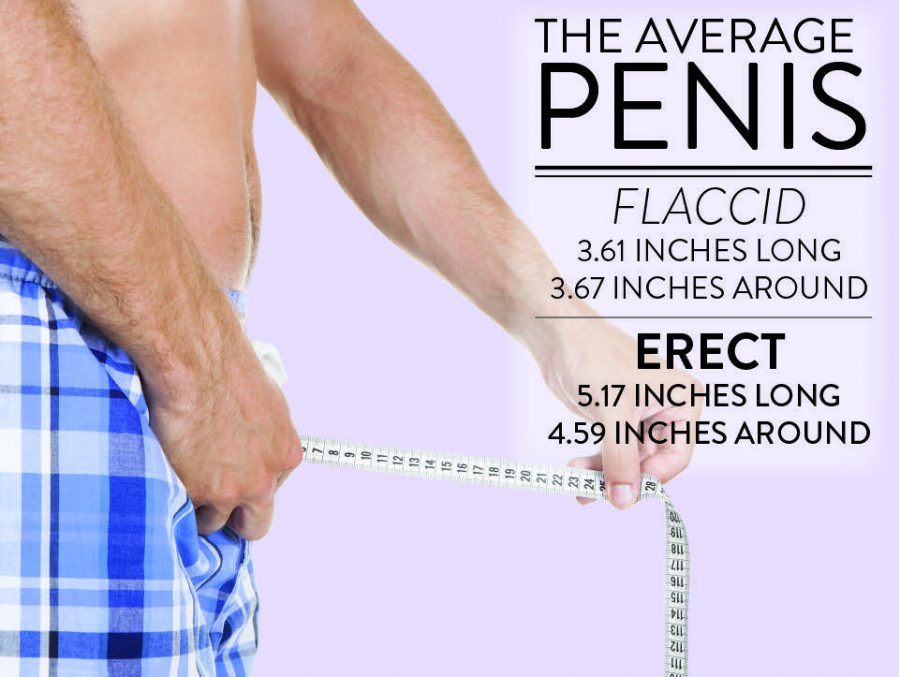Science sizes up the competition
Man measuring his penis size
March 19, 2015
One of the most common questions men ask Google is: “How big is my penis?” With more than 3,000 monthly searches, the quest to see how men measure up to each other has migrated from the Internet to the labortory.
A recent study released by the British Journal of Urology titled “Am I normal?” revealed that the average male penis length is 5.17 inches erect and 3.61 inches flaccid, and that the average circumferences are 4.59 inches erect and 3.67 inches flaccid.
Researchers at King’s College London analyzed data from more than 15,000 men who undertook penis size measurements from professional health care providers using a standardized procedure.
“I was somewhat surprised that the average length was smaller than popular notions,” said John Hodsoll co-author of the study and a statistician at the Institute of Psychiatry, Psychology & Neuroscience at King’s College London, said in an emailed statement.
The BJU study was conducted using reliable measures of penis length taken from twenty preexisting studies. There was a wide range of data available, but more sample sizes for certain measurements, such as erect length, would have been useful, Hodsoll said in an email.
The study suggests that the determination of an “average size” may be important in assessments of men complaining of having a small penis. Men may visit urologists or sexual medicine clinics with a concern about their penis size, despite their size falling within the normal range, according to the study.
Michelle Herzog, a sex and relationship therapist at the Center of Mindful Living in Chicago, said she treats male patients who come in seeking professional help because of doubts that they are adequate and normally sized below the belt.
“I think that a lot of [men] look to professionals, therapists and urologists to normalize that it’s not just you that feels this way,” Herzog said. “Here are some numbers and statistics that say you are within average range—there is nothing wrong with you.”
Small penis anxiety is a behavior-driven diagnosis that causes men to distress and become preoccupied with excessive self-consciousness of their penis size and shape, according to the study.
“There are a variety of reasons why men come in with small penis anxiety,” Herzog said. “Men watch pornography, where the average male model penis is between seven and nine inches long—they’re hired for that reason. People don’t realize they are off on the sidelines using penis pumps, taking Viagra to make them look bigger. It’s not representative of the male population.”
When men go to her seeking professional help regarding small penis anxiety, Herzog said they first ask about average size and she assures them that studies accurately reflect that the average size is around five inches.
Hunter Wessells, a professor of urology and chair of the Department of Urology at the University of Washington School of Medicine in Seattle, did a smaller scale study that established “normal” for adult men to help them understand the controversy of penile surgery.
“We were focusing on the differences between flaccid, stretch and erect length,” Wessels said. “We were able to establish there was a close correlation between the stretched and erect length and little correlation between the flaccid lengths. What we were surprised about [was] that it was pretty consistent with other reports, given the variation and methodology to measure people in different reports.”
Neither study reflected size based on ethnicity, background or age, though. According to Wessells, they have never done analyses by ethnicity and race because they did not think it would be statistically meaningful given the small number of subjects in his study.
Heerzog said it is important to help her clients be skeptical about cosmetic surgery and that she hopes her clients find comfort in studies such as the BJU’s to show that clients are in the average range. According to Herzog, after asking her clients’ size, she finds that most of the men are actually above the average penis size.
“You don’t need cosmetic surgery,” Herzog said. “It will cause way more harm and psychological issues than people realize. I do think that if a physician or therapist is educated and up to date with the current research [like this], then yes, it’s possible to change somebody’s point of view of [thinking he has a small penis].”
Herzog said she assures clients that their portrayal of penis size is inaccurate and tries to provide clinical advice to help cure small penis anxiety that many men suffer from.
“I can ask questions about their size and I will tell them that they are in average range,” Herzog said. “It’s just explaining that to them and normalizing their anxiety. It’s important to find out why it’s so anxiety-provoking because it can cause erectile dysfunctions and make them more self conscience. We are good at talking ourselves into issues that we don’t have.”








